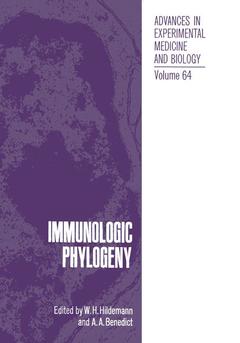Immunologic Phylogeny, Softcover reprint of the original 1st ed. 1975 Advances in Experimental Medicine and Biology Series, Vol. 64
Langue : Anglais
Coordonnateur : Hildemann W.

There are two now classic reasons for the widespread and con tinuing interest in the phylogeny of immune reactivities and structure. First is the fundamental concern of biologists with the evolution of defense mechanisms. We are eager to discover origins, mechanisms, and adaptive specializations of immunocompetence because the very existence of individuals and entire species is involved in a most essential way. Second is the strong biomedical interest in adaptive immune mechanisms to increase understanding of health and disease in man. If man and placental mammals represent the quin tessence of immunoresponsiveness with complex interdependent path ways, the less elaborate but fully functional systems of immunity in "lower" animals proffer insights applicable to immediate con cerns in medicine. Recent approaches to organ transplantation, immunotherapy of cancer and repair of immunodeficiency diseases, to name just a few areas, have depended greatly on phylogenetic per spectives. In a larger sense, intelligent wildlife conservation, utilization of food resources, and adequate environmental protection all hinge on knowing how diverse species survive or otherwise suc cumb to insults, injuries, and disease. The phylogenetic immunologist also seeks detailed information on the structure of the immunoglobulins which relates directly to the evolutionary history of living animals. Perhaps genetic mech anisms responsible for the evolution of these proteins may be re vealed as spin-off information. The vast number of immunoglobulin specificities and effector structures, coupled with the remarkable phylogenetic conservation of certain polypeptide regions, makes these molecules especially useful to protein chemists as well as immunologists.
Tridacnin, a Potent Antigalactan Precipitin from the Hemolymph of Tridacna maxima.- Anti-Galactan Precipitins in the Hemolymph of Tridacna maxima and Limulus polyphemus.- Protectins in Argentine Mollusks: Immunological and Immunochemical Aspects.- Immunologic Significance of Specificities of Cellular Agglutinins of Limulus polyphemus.- Some Specific Aspects of Cell-Surface Recognition by Sipunculid Coelomocytes.- Response of Earthworm Leukocytes to Concanavalin A and Transplantation Antigens.- Recognition Factors of the Crayfish and the Generation of Diversity.- Endosymbiosis and Cellular Tolerance in the Hawaiian Soft Coral Sarcothelia edmondsoni Verrill.- Hard Tissue Tumors of Scleractinian Corals.- The Discriminatory Capacity of Phagocytic Cells in the Chiton (Liolophura gaimardi).- Direct Evidence of Heterolysis of Gorgonian Target Cells.- Immunoincompatibility Reactions in Corals (Coelenterata).- Allogeneic Distinction in Botryllus primigenus and in Other Colonial Ascidians.- Characteristics of Cell-Mediated Immunity and Memory in Annelids.- Specific Rejection of Integumentary Allografts by the Sea Star Dermasterias imbricata.- Preliminary Structural Characterization of Pacific Hagfish Immunoglobulin.- Antibodies against Salmonella and SRBC in Urodele Amphibians: Synthesis and Characterization.- Immunoglobulins in Ranid Frogs and Tadpoles.- Structural Data on Chicken IgA and Failure to Identify the IgA of the Tortoise.- Evolutionary Divergence of Immunoglobulin Constant Region Genes.- Evolution of Conformational Flexibility of Immunoglobulin M.- Relationship between Structure and Function of Lower Vertebrate Immunoglobulins.- Quantitative and Qualitative Aspects of the Antibody Library of Sharks.- Ultrastructure of Hagfish Blood Leucocytes.- Cell Surface Immunoglobulins of Thymus and Spleen Lymphocytes in Urodele Amphibian Pleurodeles waltlii (Salamandridae).- Structure and Immunological Function of Lymphomyeloid Organs in the Bullfrog Rana catesbeiana.- Lymphoid Organs and Amphibian Immunity.- Cellular Aspects of Humoral Immune Responsiveness in Chelydra.- Bursal and Thymic Alloantigen Expression in Lymphoid Tissues of the Chicken.- In Vitro Responses of Urodele Lymphoid Cells: Mitogenic and Mixed Lymphocyte Culture Reactivities.- Transplantation Immunogenetics and Mixed Lymphocyte Culture Reactivities of Partially Inbred Strains of Salamanders (A. mexicanum): Preliminary Studies.- Mitogens as Probes for Studying Temperature Effects on the Development of Immunocompetent Cells in Poikilothermic Vertebrates.- Synergistic and Antagonistic Effects of Mitogens on Proliferation of Lymphocytes from Spleens of Rana pipiens.- Mitogens as Probes of Lymphocyte Heterogeneity in Anuran Amphibians.- Thymic Function in Amphibians.- Phylogenetic Aspects of Hypersensitivity: Immediate Hypersensitivity Reactions in Flatfish.- Immunity in the Developing Amphibian.- Demonstration of an Inverse Relationship between Regenerative Capacity and Oncogenesis in the Adult Frog Rana pipiens.- Polyfunctional Antigen-Binding Specificity in Hapten-Carrier Responses of the Newt Triturus viridescens.- Surface Characteristics of Spleen Cell — Erythrocyte Rosette Formation in the Grass Frog Rana pipiens.- Phylogeny of Functional Humoral Transplantation Immunity: Comparative Studies in Amphibians and Rodents.- Genetic Control of Immune Responses in Chickens.- The Genetics of Chicken 7S Immunoglobulin Allotypes.- Use of the GVH Reaction to Investigate the Regulation of the Humoral Immune Response.- Immune Facilitation of Allograft Survival across RestrictedDifferences at the H-2 Compex.- Induction of Unresponsiveness to Organ Transplants in Congenic Strains of Rats and Other Mammals.- Many Questions (and Almost No Answers) about the Phylogenetic Origin of the Major Histocompatibility Complex.
Date de parution : 06-2013
Ouvrage de 485 p.
17.8x25.4 cm
Thème d’Immunologic Phylogeny :
Mots-clés :
diseases; immunity; immunodeficiency; immunoglobulin; immunotherapy; organ transplantation; placenta; proteins; transplantation
© 2024 LAVOISIER S.A.S.



